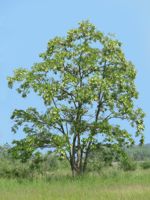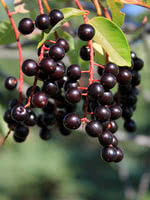Mon-Fri 9am - 5pm Mountain time
Western Chokecherry vs Black Locust
Robinia pseudoacacia
Prunus virginiana var. demissa
Black Locust is an attractive tree. Its distinctive leaves are made of about a dozen bright green leaflets. It also notable for its fragrant white flowers, which smell of citrus.
Black Locust can grow in many situations, but prefers dry areas with lots of sun. It is robust and is an excellent choice for establishing shade in dry, open areas.
Important note: Much of the Black Locust is toxic to humans and livestock, including seeds, bark, and leaves.
Western Chokecherry is a shrub or small tree commonly used for farmstead and field windbreaks.
It produces white flowers in the spring and edible dark purple fruit that matures between September and October. Its cherries are great for making for making jams, jellies or wine, but are not very palatable for raw eating.
Black Locust Quick Facts
Western Chokecherry Quick Facts
Toxicity: toxic to horses, cattle, etc.)

